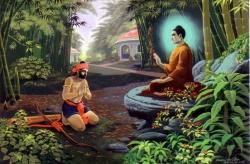Ajitakesakambala
Head of one of the six heretical sects mentioned in the Pitakas as being contemporaneous with the Buddha. He is described as a Titthaka (heretical teacher), leader of a large following, virtuous and held in esteem by the people (S.i.68).
According to the Sāmaññaphala Sutta (D.i.55), where Ajātasattu describes a visit paid to Ajita, he taught the doctrine of "cutting off," i.e. annihilation at death. He was a nihilist who believed in neither good nor evil. In Tibetan sources he is stated to have taught that all beings must dwell in Samsara for 84,000 mahākalpas before they come to an end; nothing can prevent that (Rockhill: 103-4). The answer Ajita gave to Ajātasattu is given elsewhere (E.g., S. iii.207; M.i.515) as being the view of a typical sophist. His name is often introduced into the stereotyped list of the six teachers even where the views they are alleged to have expressed do not coincide with those attributed to Ajita in the Sāmaññaphala Sutta. E.g., S.iv.398, where he is represented as talking about the rebirths of his adherents - he who denied rebirth. In A.i.286 he seems to have been confused with[ Makkhali Gosāla. He was called Kesakambali because he wore a blanket of human hair, which is described as being the most miserable garment. It was cold in cold weather, hot in the hot, evil-smelling and uncouth (DA.i.144; MA.i.422-3).
According to the Mahābodhi Jātaka the Buddha had already refuted Ajita's view in previous births (J.v.246). Ajita was evidently much older in years than the Buddha, for we find Pasenadi, in the early years of his friendship with the Buddha, telling him that he was a young novice compared with Ajita. S. i.68.
In the Milinda-pañha the king says that he had visited a teacher named Ajitakesakambala. This cannot possibly refer to our Ajita; the reference is probably to a teacher belonging to the same school of thought ("There is neither fruit nor result of good or evil karma," p.4. His views are given on p.25 without mention being made of his name. But see note 2 to the Mil. trans., p.8.).
References to ascetics wearing hair garments are found in several passages of the Pali canon. D.i.167; M.i.77, 238; A.i.240; for a discussion of Ajita's views see Barua.: Pre-Buddhistic Indian Philosophy, pp.287ff.
